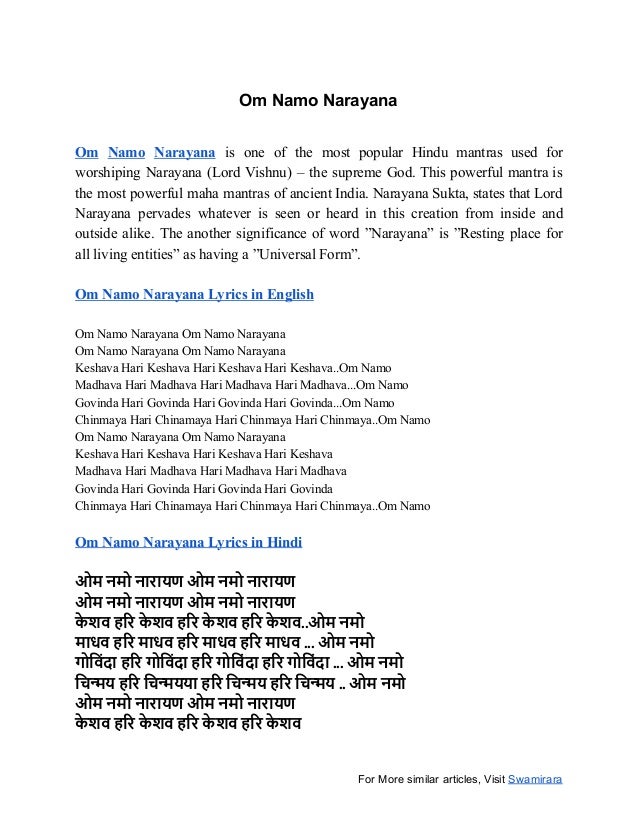Om Namo Narayanaya Meaning
The Ashtakshara mantra — Om Namo Narayanaya — is simple to utter, but potent in power. All the Azhvars have stressed the importance of the name 'Narayana.' In Andal's Thiruppavai, the name Narayana occurs in the very first verse. Narayana is the name of the Supreme God in his infinite all pervading form.

| Part of a series on |
| Vaishnavism |
|---|
|
|
|
|
|
Om Namo Bhagavate Vasudevaya (listen) (in devanagari: ॐ नमो भगवते वासुदेवाय) is one of the most popular Hindumantra and the most important mantra in Vaishnavism. It is called as Dwadasakshari Mantra or simply Dwadasakshari meaning the 'twelve-syllable' mantra dedicated to Lord Krishna/Vishnu.[1][2] It has two traditions—Tantric and Puranic. In Tantrik Tradition, the Rishi of the Mantra is Prajapati, in Puranic Tradition the Rishi is Narada. Both, however, say it is the Supreme Vishnu Mantra.
Sharada Tilak Tantram says:
Namo Narayana Center
| “ | 'Dvadasharno mahamantrah pradhano Vaishnavagame'— Meaning: the twelve lettered mantra is the chief among vaishnava mantras. | ” |
Om Namo Narayanaya Meaning In Tamil
Similarly, this is the ultimate mantra in Shrimad Bhagavatam. This twelve syllable mantra[3] is known as a Mukti (liberation) mantra and a spiritual formula for attaining freedom.[4] This mantra can also be found in Vishnu Purana.
Meaning[edit]
Om Namo Bhagavate Vasudevaya means 'Om, I bow to Lord Vasudeva or Lord Krishna'.[5]

| Term | Devanagari | Listen | Meaning |
|---|---|---|---|
| Om | Om | Refers to the Supreme Infinite Spirit or Person. Om represents the ShabdaBrahman. | |
| Namo | Namo | Salutation, worship, a common spoken valediction or salutation originating from the Indian subcontinent. 'Namo' नमो is the Sandhi form of 'namas' नमस्, neuter nominative singular. | |
| Bhagavate | Bhagavate | 1. God in Sanskrit, someone who is considered God (or equally powerful, merciful). 'Bhagavate' भगवते is the dative of 'bhagavat' भगवत्. 2. Bhagavate is one who is becoming divine.[6] | |
| Vasudevaya | Vasudevaya | Name of Krishna, Krishna is also known as Vaasudeva (Krishna), because He was the son of Vasudeva. In the Bhagavad-Gita, Arjuna called Krishna by the name Vaasudeva multiple times. 'Vāsudevāya' वासुदेवाय is the dative of 'vāsudeva' वासुदेव. Other meaning for Vasudevaya is Vasu means 'Life in all beings' Devaya means 'God'. This means God(life/light) who lives of all beings. |
Importance[edit]
Om Namo Bhagavate Vasudevaya means 'prostration to Vasudeva' who is variously understood as Krishna or Vishnu.'[7] Krishna Himself asked His devotees to completely surrender to Him:
| “ | सर्वधर्मान्परित्यज्य मामेकं शरणं व्रज । अहं त्वां सर्वपापेभ्यो मोक्षयिष्यामि मा शुचः ॥१८- ६६॥ | ” |

Krishna also proclaimed 'Everybody should recite 'Om Namo Bhagavate Vasudevaya' mantra daily whenever possible so that I will stand by them. I respond to the call of the heart immediately and invariably. See Me in your duties. I am committed to those who are committed to their duties. Believe in putting faith in Me and make Me your own'.[8]
Popular culture[edit]
- Dhruva used this as his mantra in his penance. Dhruva was initiated by Narada into chanting.[9]
- Swami Vivekananda used this phrase multiple times in his lectures and letters.[10][11]
- Swami Sivananda suggested to repeat mantras like Om or 'Om Namo Bhagavate Vasudevaya'.[12]
- Vedanta philosopher Dayananda Saraswati wrote a book named 'Om Namo Bhagavate Vasudevaya'.[13]
See also[edit]
References[edit]
- ^Prabhakar Balvant Machwe (1983). Bhāratīya Saṃskr̥ti, Volume 1. Bhāratīya Saṃskr̥ti Saṃsada. p. 212.
- ^Edwin F. Bryant. Krishna: A Sourcebook. Oxford University Press. p. 354. Retrieved 18 June 2007.
- ^Alexander Studholme (2002). The Origins of Oṃ Maṇipadme Hūṃ: A Study of the Kāraṇḍavyūha Sūtra. SUNY Press. p. 177. ISBN978-0-7914-5389-6. Retrieved 24 June 2012.
- ^'Om Namo Bhagavate Vasudevaya'. Retrieved 14 April 2012.
- ^J. Donald Walters (1 March 2002). The Art and Science of Raja Yoga: Fourteen Steps to Higher Awareness : Based on the Teachings of Paramhansa Yogananda. Crystal Clarity Publishers. pp. 251–. ISBN978-1-56589-166-1. Retrieved 24 June 2012.
- ^'Chanting Om Namo Bhagavate Vasudevaya'. Retrieved 14 April 2012.
- ^Swami Krishnananda. 'The Significance of Mantra-Japa Sadhana'. swami-krishnananda.org. Retrieved 14 April 2012.
- ^'Autobiography Of Parampoojya Leelavati Karve'. yogeshwar.org/. Retrieved 4 May 2012.
- ^'Dhruva'. Vaniquotes. Retrieved 14 April 2012.
- ^'Swami Vivekananda Letters'. Vedanta network Boston. Retrieved 14 April 2012.
- ^'Swami Vivekananda letter the 15th February [1893]'. Ramakrishna Vivekananda Info. Retrieved 14 April 2012.
- ^'20 Instructions by Swami Sivanananda'. Writespirit. Retrieved 14 April 2012.
- ^'Om Namo Bhagavate Vasudevaya by Swami Dayananda Saraswati'. vedicbooks.net/. Retrieved 4 May 2012.
Narayan Temple on Narayanhiti palace premises, Kathmandu, Nepal
Oldest Sridhar Narayan statue at Naksaal, Kathmandu
The bow of Royal Barge Narai Song Suban HM Rama IX of Thailand, it carved a image of Narayana ride a Garuda
Idol of Narayana around 14/15th century, found at the Devasathan, inner Bangkok, Thailand
Idol of Narayana ride a Garuda in front of InterContinental Bangkok, Phloen Chit Road, it is one of the most respected Hindu shrines in the Ratchaprasong neighbourhood alike Erawan Shrine
Drawing of sleeping Narayana on Sheshanaga while the four-headed Brahma springs from his navel
Statue of Narayana in Thai art style stands on Mount Mandara within Suvarnabhumi Airport, Samut Prakan, Thailand
Lintel depicting Narayana sleeping upon the Sheshanaga in the middle of Milky Ocean, Bangkok National Museum